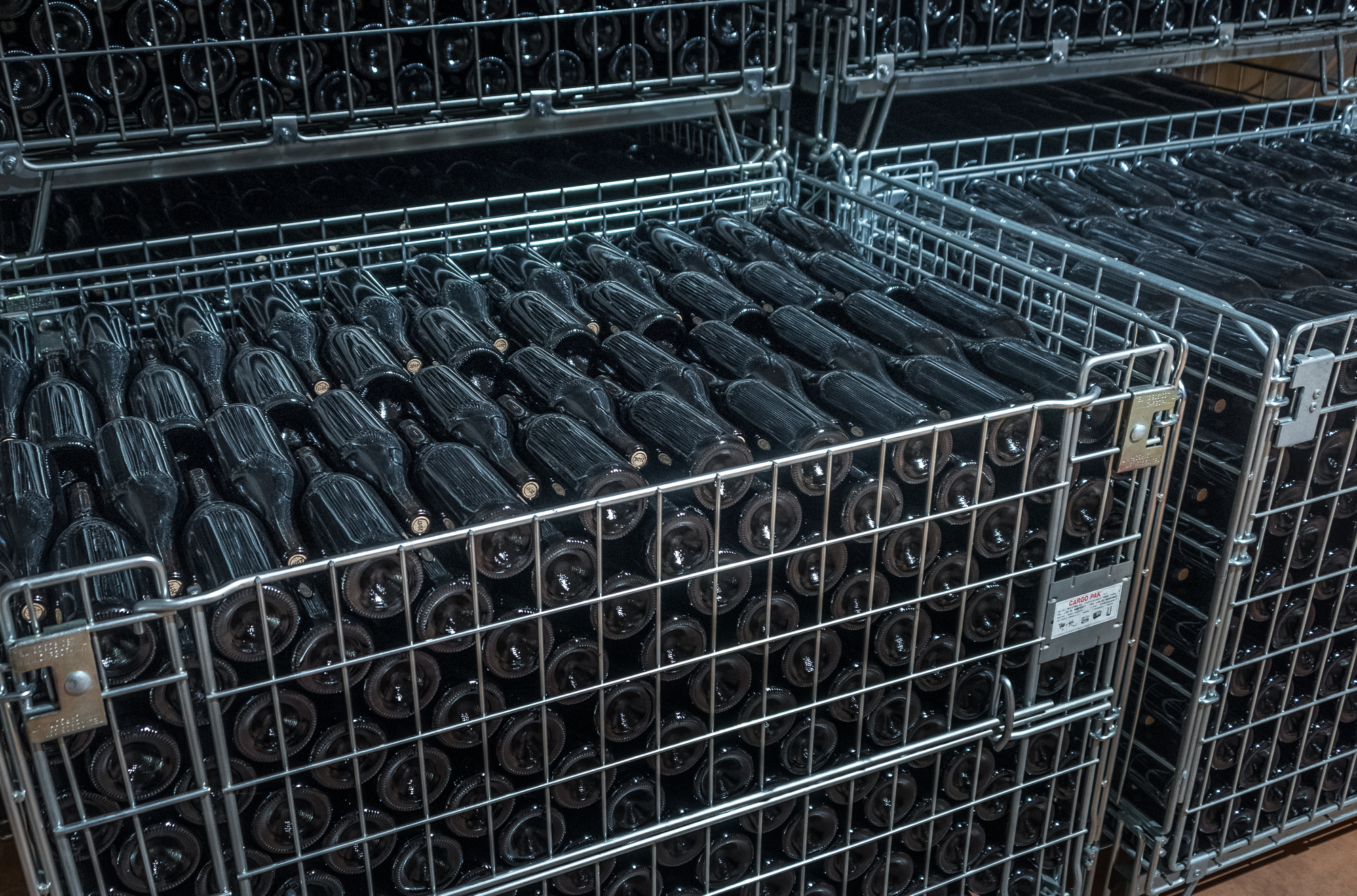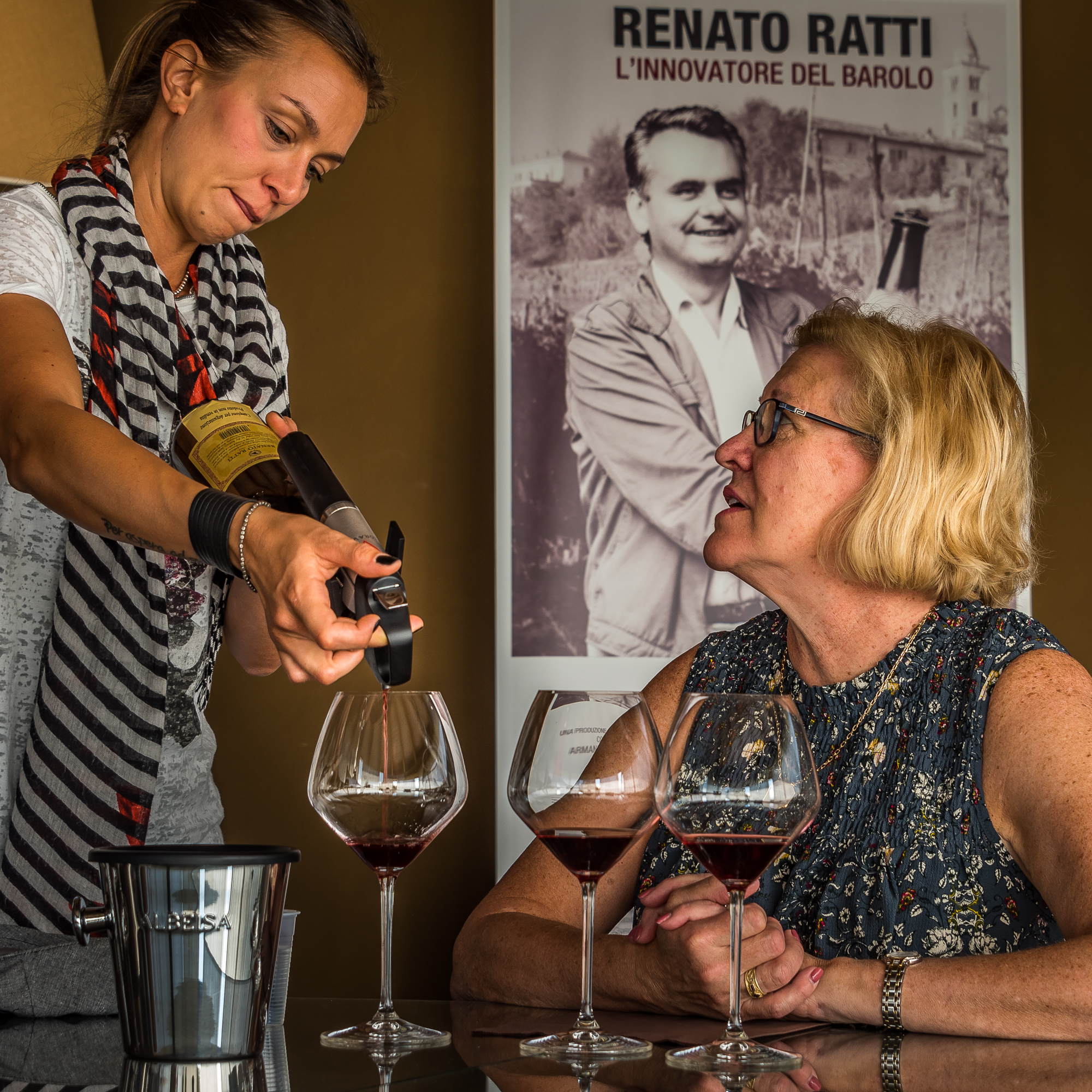‘The King of Wines’: that’s the title bestowed on the Barolo wines of the Langhe region of northern Italy. And Renato Ratti’s Barolo is the culmination of decades of this royal lineage. We experienced the charm of Renato Ratti during the fall of 2018.
The Langhe is a beautiful area of the Piemonte, or ‘foot hills’ (Piedmont in English…and why do we change place names like that, by the way?).
The view like this one from the Renato Ratti winery is breathtaking, and it is typical of the views within the Langhe.
Click any image for a larger view
“Our recommendation? Go to the Renato Ratti winery to experience the Barolo wine-making process. Visit their beautiful facility with one of their informed hosts. Then opt for the higher-end wine tasting that will find you sampling several vintage Barolo wines.”
The Grape
The predominant grape of the Langhe is the Nebbiolo grape, seen here growing on the hillside vineyard of Renato Ratti.
This beautiful grape gives Barolo wines its body and rich color. And by the way, it is also the grape of the Barbaresco wines of the Piemonte, though the Nebbiolo grape for Barbaresco is grown a few miles away in a different micro-climate and in significantly different soils.
The Founder
Renato Ratti is the founder of this fine winery. After spending his younger years learning the art of wine making in Brazil, he returned to his native Italy in 1965 to begin his legendary journey in the vinification of Barolo wine. On the hillside immediately above the current winery lies the Abbey of L'Annunziata. It is in this 14th Century abandoned abbey that he created his first vintage of Barolo.
This is the man, himself — Renato Ratti. Doesn’t he look like a man you would have liked to have called ‘a friend’? And not just because of that large bottle of Barolo he is holding!
Renato Ratti came into the wine business with what to me seems like a bit of an edge…he had no family history of wine making…he had no regimented tradition that, though historical, may have been flawed, or non-productive. It’s best said in his own words: “I came to the world of winemaking without a family tradition behind me. I believe that this opening admission is necessary, for being free of any ancestral ties or responsibilities, I was able to face Barolo with neither pride nor prejudice, but with unfettered freedom.” Unfettered freedom…I like that aspect of his learning process.
Sadly, Renato passed away in 1988 at the young age of 54. Fortunately for the wine industry, his son Pietro had recently graduated from nearby Alba's renowned Enological School. Pietro took charge of the company and has guided it into the 21st century, including construction of the modern, new winery in 2002.
The Locale
A visit to Renato Ratti winery is special in many ways — from the greeting, the creative introductory video, the unique gravity-inspired winery, and of course, the tasting of Renato Ratti’s fabulous wines.
The winery sits on a hillside below the town of La Morra, the dominant town of the Barolo wine region.
In the aerial view below, you can see one of the aspects that makes Renato Ratti winery so unique. It is difficult to see the footprint of the winery (bounded in red) because of the vegetation-covered ‘green’ roof. This winery is vertically oriented, rather than being spread out over acres.
The original location of the winery in the 14th-century Abbey of L'Annunziata is bounded in blue.
The fact that the winery sits on the slope of a hillside leads us to the other unique aspect of this winery. The slope of the hillside allows the flow of gravity to work for Renato Ratti, eliminating the need for needlessly agitating the wine through pumping during the vinification process.
Here you can see from the elevator panel that there are a total of 5 floors in the winery.
And thick concrete walls hold back the hillside in the subterranean levels of the winery.
And the soil that produces the Nebbiolo grape variety? Beautiful! Really?
I must say that, like a baby that only its mother would call beautiful, the soil is beautiful only to a vintner. In this photo from the Renato Ratti winery’s web site, you can see the calcareous soil responsible for the growing of the Nebbiolo grapes that produce such a fine wine — very little organic, lots of mineral. Molto perfetto!
Our Visit
Upon our arrival, we found this modern facility for the production of Barolo wine. Note the green roof. And the beautiful countryside of the Langhe.
Barolo is not the only wine vinified by Renato Ratti - here are some of the wines, and a grappa, that are produced by Renato Ratti. Click on an image for a larger view.
Behind this wall of wooden wine boxes sit the staff of Renato Ratti winery, busily filling orders for their wonderful selection of wines.
After being greeted by our beautiful host for the tour, Christine, she directed us to a video that blew our minds!
This video was prepared by Pietro, himself. It is the most creative and informative video we have ever seen that explains the history and origins of a wine production area. If you are at all interested in Italian wine, you will be well rewarded if you click on the video thumbnail to view Pietro’s hand-crafted masterpiece.
Our tour quickly moved to the vinification floors.
As we were in Italy at harvest time, the grape-handling process was in full swing. Here is where grapes are fed into presses for extraction of their juice.
After grapes are destemmed and crushed, they undergo a thermo-controlled fermentation in the steel vats.
Malolactic fermentation in November is then accomplished in oak barrels.
An elevator takes us below the fermentation tanks to the aging barrels.
Here Craig, Leslie, my wife Ellen and I learned about Renato Ratti’s wine production process from our host, Christine.
A soon-to-be-delicious Barolo Marcenasco waits its turn to be bottled after 2 years of aging. But wait…don’t drink it right away…this fine wine can wait for you for over 20 years. We soon learned the benefits of letting the wine age in your home cellar, so read on.
In this deep, dark cellar, we saw bottles awaiting their fill, as well as the Ratti’s own private reserve of bottled wines.
The Tasting
As Craig soon found out, like all of the other aspects of the Renato Ratti winery, the tasting room was gorgeous.
Besides wanting to know how Barolo wine tastes, we also wanted to know how aging of wine affects the enjoyment of red wines. We opted to purchase the Exclusive Tasting. This allowed us to experience the impacts of progressively-aged vintages of the Renato Ratti Barolos.
WARNING: Don’t try to enjoy a vintage wine-tasting experience with a stuffy nose! There is a lot of sniffing required to fully enjoy the experience!
Christine was a wonderful host — she is knowledgeable and willing to answer all of our questions.
[NOTE: The Coravin device that Christine is using allows one to sample wine from a bottle without removing the cork; thus preserving the wine from destruction through oxidation. We have been able to sample 30-year old wine using this excellent device. See a full Coravin description here.]
Seen here are the wines we tasted. Christine gave us an excellent interpretation of each of these wines. We started with the Nebbiolo, as a representation of a young wine that only ages for about one year before release. Then we worked our way across with Barolos from 2014, 2013, 2004 and finally, a 20-year old 1998.
What did we learn from this tasting?
First, we learned that a Barolo, being a full-flavored and full-bodied wine, should be aged in your cellar before being uncorked. It is best to drink between 6 to 12 years after the vintage. As we learned upon tasting each vintage, the flavor comes out as the tannin drops over time. The tannin of the younger Barolo wines will suck the moisture right out of your mouth...your lips kind of get stuck to your teeth. As the tannin drops, the elegant flavor of the wine becomes more evident.
Second, we learned that the color changes significantly over time: moving from the typical garnet red in the younger wines, to a not-off-putting orangy-brown in the later vintages. Don’t take the color change as a flaw…consider it a feature.
The Labels
We were intrigued by the labels on some of the non-Barolo wines that Renato Ratti winery produces. You will note that there are uniformed militia featured on six of the labels.
Ratti’s research into the history of the Barolo area revealed that each of the hill towns put together a uniformed militia to combat invading armies, like Napoleon’s. Matching the geography of these hill towns to the location of vineyards supplying grapes for their wines, the Rattis developed the labels for the regionally-associated wines.
In this example, the militiaman of 1775 served in the Asti regiment, about 20 miles northeast of the Renato Ratti winery.
Our Recommendation
Go to the Renato Ratti winery to experience the Barolo wine-making process.
Visit their beautiful facility with one of their informed hosts.
Then opt for the higher-end educational wine tasting that will find you sampling several vintage Barolo wines. You will not be disappointed.
Here is a closing photo from our wonderful time at the Renato Ratti winery. In the photo, from left to right are: my wife Ellen, our host Christine, brother- and sister-in-law Craig & Leslie, myself, and the driving force behind the Renato Ratti winery, Pietro Ratti.
We were pleased that Pietro, when we mentioned that we were from the Denver area, immediately offered, “Ahh, the Barolo Grill!”. He knows it well, as it has been a stop in the annual take-your-employees-to-Italy trip that Barolo Grill conducts. Wouldn’t a place that takes the staff to Italy each year be a wonderful place to work?! It certainly is a wonderful place to eat!
Coravin Wine Preservation System
Barolo Grill Restaurant in Denver
I hope you enjoyed our wonderful time spent at the Renato Ratti Winery in the Langhe region of Piemonte, Italy. If we run into you there upon our next visit, I’ll buy you a bottle of wonderful Barolo wine! Otherwise, Renato Ratti wines are readily available at restaurants and wine shops in the U.S.
Ciao for now,
Steve


















